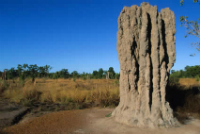4 Problems Preventing Termite Control
 Before Termite Treatments There is Termite Control. Now is the time to strike! Act quickly before termite swarming season is upon you. What? You’re not sure what termite swarming season is? Well sit down young grasshopper and I can explain, for this is an important lesson. Termites eat wood ‘n’ stuff, and your home is made of wood ‘n’ stuff.
Before Termite Treatments There is Termite Control. Now is the time to strike! Act quickly before termite swarming season is upon you. What? You’re not sure what termite swarming season is? Well sit down young grasshopper and I can explain, for this is an important lesson. Termites eat wood ‘n’ stuff, and your home is made of wood ‘n’ stuff.
Wood ‘n’ stuff is also commonly referred to as cellulose. Cellulose is an organic compound with theformula (C6H10O5)n, a polysaccharide consisting of a linear chain of several hundred to over ten thousand β(1→4) linked D-glucose units. Or, if that sentence made you go cross eyed, cellulose is a fundamental building block of wood ‘n’ stuff. It is found in wood, sheetrock and other building materials used to make you a house. Termites eat wood ‘n’ stuff.
These suckers are the most economically important wood destroying organism in the U.S. Americans spend about $2 billion per year for prevention and treatment. This figure qualifies as “mucho dinero” and I assume it also includes some American money too (ha! I am so funny).
But seriously here are some relatively simple, inexpensive, and practical measures that can be taken around the home that will greatly reduce the risk of subterranean termite infestations. These are steps to take before you need to know how to get rid of termites. Preventive measures like these are very cost effective steps towards termite control before you need a termite treatment. Most homeowners will feel good about investing a little time towards termite and pest control in order to protect your biggest purchase ever. These are all steps to take prior to needing a termite treatment. These tips will not help or tell you how to get rid of termites.
Problem #1
- Cellulose (wood ‘n’ stuff) touching soil or ground provides termites with good food. Not termite control. Like at all. Termite and pest control professionals scoff at this and you should too.
Solutions:
- Keep all wood 3 to 6 inches off the ground
- Keep flower bed and mulch levels 3 to 6 inches below siding and wooden portions of structure.
- Avoid wood mulch next to foundation
- Remove dead trees, stumps, and roots near your home
- Never store firewood, paper, or lumber against the home’s foundation or in the crawl space. If you don’t do this it is only a matter of when not if you will need a termite treatment.
Problem #2
- Moisture accumulation around the home or in the crawl space provides a needed water source for termites. Again, not termite control. And yes, termite and pest control professionals also scoff at this. You should too.
Solutions:
- Grade or slope soil away from foundation
- Maintain clean gutters and down spouts.
- Install down spout extenders and splash blocks.
- Use drain tiles if sit is flat.
- Divert lawn sprinklers and irrigation water away from foundation
- Promptly repair leaking faucets, water pipes, and air conditioning units.
- Use mulch sparingly
- Keep all your plants and vegetation trimmed and places them at least 3 feet from foundation.
Problem #3
- Poor ventilation in crawl space provides water needed for termite survival
Solutions:
- You can use a vapor barrier to cover the soil in the crawl space.
- Install 1 square foot of vent opening 150 square feet of crawl space area.
- Try to enhance cross ventilation with good placement of vent openings.
- Remove any vegetation or obstacles covering vents around the home.
Problem #4
- Hidden termite access
Solutions:
- Install trellises and trim plants so they don’t contact the house.
- Do not build flower planter or any other permanent walkway or yard architecture to where they are touching the house.
- Regularly inspect cracks or joints in concrete slabs for evidence of termites.
- Install metal flashing when attaching porches or decks. This is true even when using treated lumber.
- Remove mulch that contacts siding or obscures a clear view of the foundation.
- Never install foam board insulation (polystyrene) below grade.
Overall Check List for your own inspection of a property
- Make sure water is directed away from the foundation.
- Move all wood and other cellulose materials (including mulch) away from the foundations.
- You should be able to see the foundation all the way around the home.
- You want the basement or crawl space to be relatively dry throughout the year.
These are all issues that as a professional termite treatment provider we will be looking for. These types of conducive conditions give pest control professionals an idea of danger from termites and where and how to treat if active termites are found. If you would like to speak to a professional about your home and what you can do to lessen chances of a termite infestation please contact The Bug Master and we can take a look. If you are past all this and just need to know how to get rid of termites, please call us but even then we will still tell you to take these steps!
